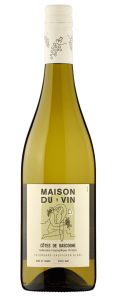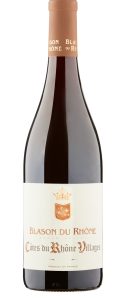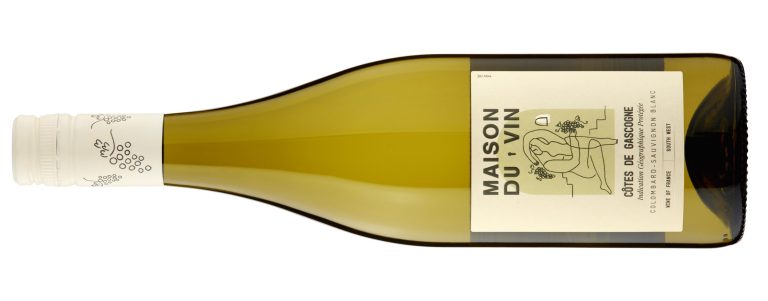For today’s Top Tips, I pitch our tent in Southern France – with a red from its eastern part and a white from the west.
There is a bit of contrast though as the white is from a region that has been something of a secret treasure trove until quite recently.
Despite centuries in the shadow of Bordeaux, SW France has what The World Atlas of Wine describes as “France’s most varied collection of indigenous wine grapes, some only recently rediscovered”.
Discover some of its charms today.
Meanwhile, its companion red is as traditional and long standing as berets and baguettes.
Southern Rhȏne vines (now running to 70, 000+ acres) have been producing wine at least since Pope Clement V moved the papal court to Avignon in 1309.
Little did Clement know that 700 years later his “New Castle of the Pope” would be one of the world’s best known wine labels.
Here, then, is a classic blend from thereabouts to sit beside a white wine from an area that is only just beginning to be widely appreciated.
In the usual way, hyperlinks and pictures are used where possible to help you locate the bottle in question.
Let’s start with the white
2022 Maison du Vin Cotes de Gascogne (£8 at Co-op and 11.5% abv):

If you love sauvignon blanc, this excellent SW France option may also tickle your taste buds; it enriches that variety’s joys by blending it with colombard.
Textured and beautifully clean, the primary result is white wine with greengage, cooked apple and melon flavours.
These are combined with lively grapefruit and sherbet acidity and supplemented by suggestions of peach.
Click here for the hyperlink …. https://www.coop.co.uk/products/maison-du-vin-cotes-de-gascogne
And for that red
2021 Blason Du Rhȏne – Cȏtes Du Rhȏne Villages (£7.99 – instead of £10.99 from Wednesday – at Waitrose and 14.5%):

Two possible options with this one – get it now as part of Waitrose’s “Buy Six” promotion (if it applies where you are) or wait until Wednesday.
Either way, this is one of those typical, solidly reliable, grenache-led red blends from the Southern Rhône.
It is brimful of sweet-edged fruit-like flavours (bramble, blackcurrants, cherries and a modicum of plum).
All that is generously supplemented by suggestions of black pepper, dried herbs and chocolate, but with oak derived influences too.
Click here for the hyperlink … https://www.waitrose.com/ecom/products/blason-du-rhone-cotes-du-rhone-villages/369052-276272-276273
See you again on Thursday when the focus switches to the upcoming English Wine Week.









16 responses
Hi Brian,
I’m back from sunny Spain on Wednesday after an extended stay and I’ll call into Waitrose to pick up some of the Cote du Rhone Villages you recommended. Incidentally you mentioned that you not a Verdejo fan, me neither, but I picked up a very nice one called ‘Yllera’ produced in Rueda, Valladolid. I usually go for Albariño when I drink a white wine.
Hi Bob., and welcome home. Very young Verdejo does work well for me, but the variety seems quickly to develop those tobacco and savoury elements that, to me, obscure the fruit but, that said, we are talking about the entry point level.
That one you pinpointed does not seem available here in the UK but there are some keen fans of Spain among subscribers – and they may be able to tell us differently.
There is a problem with Verdejo ,in that it is susceptible to rapid oxidation ,even going from harvesting in the vineyard to the winery – particularly in the heat of Rueda.Bodegas Grupo Yllera produce Yllera 100% Verdejo Vendemia Nocturna.The wine is very rapidly machine harvested at night.The label is green with a cut out moon.
You can get it direct from Spain and I have had good experiences with Decántalo .The cost is £10.53 a bottle with all U.K. taxes paid.Best to buy six bottles and delivery charge is about £11.They do not have to be the same six.I suggest looking at Basa and Ad Libitum.You do have to wait for about 2 weeks for delivery to the U.K.
Thanks for supplier details Paul and for the information about night harvesting – I did not know that producer did so. As you suggest, it is almost certainly early oxidation that makes verdejo less attractive to some of us even before the next harvest begins
Think the Verdejo Bob mentions is only available online at Decántalo or Vinissimus both for around £11/£12. I’ve tasted this one in Spain as well (a lot cheaper). I’m a big fan of Verdejo, (Verde means green in Spanish) and that kind of goes with slight vegetal character of the wine. I like the understated subtle flavour, and although the fruit doesn’t shine as much as say an Albarino, I enjoy the toastiness, and savoury elements along with melon and fennel, although get one that the fruit is more prominent and it’s a fabulous drink. For me Verdejo is very underrated.
I sense that Verdejo is to me, what Gamay is to you. Unexcited by basic options but enthused when a version works really well.
As you can see Bob., a reply from MidWeeker Paul has suggestions about why that wine appeals and how you can get it in the UK.
Hi Brian,
Just to say I like your new layout on your web site. Now so much easier to access past reviews. We done and keep up the good work!
Donald
Thank you, Donald – and accessing past reviews was one objective. Most credit must go, though, to the website specialist Dan who suffered many late nights trying to put right years of unwitting neglect on my part.
Agree about the Co-op Maison du Vin Côtes de Gascogne white wine.The Colombard ups the interest and complexity to the SB with apple and honeydew melon flavours and perhaps a zip more tartness.
I do hope people are not out off by the rather cheap looking label and possible mistranslation of the title as “House wine” rather than the correct title which Is “ Home of Wine”; because this is a quality wine.
I do think that a lot of SB is better when blended and I particularly like the classic Bordeaux white blend of about 80% SB and 20% Sémillon .The latter grape adds lovely waxy,lanolin,honey overtones.If the winemaker can squeeze in 5% Muscadelle, then it really is adding fairy dust to an exceedingly good cake.
Agree about underestimated Bordeaux sauvignon. With all their experience blending red wines, we should not be surprised that Bordeaux producers’ white wines benefit from a cocktail of grape varieties that really do ensure the totality significantly exceeds the sum of the parts.
Typo should be “ put off” not” out off”.Apologies.
I find drinking single varietal wines helps to capture their characteristics in one’s mind, but blending can certainly produce lovely & interesting wines.
A couple of recent examples from Asda:
Wine Atlas Sauvignon Blanc Roditis 2023. Greece, with 85% Roditis @ £7.
Kakapo 2023, a NZ offering of 85% Riesling, 11% Semillion, 3% Chardonnay, 1% Sauvignon Blanc. The other varieties toned down the biting acidity. At £6.25 a very interesting wine, that I enjoyed.
I guess the white wines from the Rhone is one of the best examples of the art of blending. Such a wide variety of grapes used. Of course the range of styles is of interest to the enthusiast, but could be confusing to more casual wine drinkers!
That riesling blend from Asda is on my radar so I will report back when I track some down. I recall that Tesco had something similar a year or two back which actually worked really well – but probably didn’t sell.
Hello Richard,
The previous vintage of Kakapo,which I enjoyed,was 50% Sauvignon Blanc,45% Riesling and 5% Chardonnay.Perhaps NZ Sauvignon is going out of fashion?
Possibly, equally, the age old tactic of making the best wine you can from the varieties that ripened especially well that year.